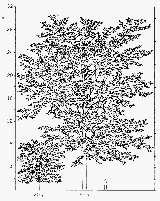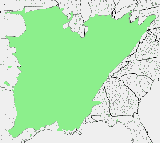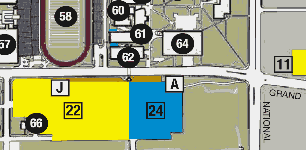


 thornless honey locust
thornless honey locustGleditsia triacanthos var. inermis
Honey locust is a medium to large tree with a mature height of 70 feet with similar spread. This tree is appropriate for all yards, parks, and harsh sites like parking lot islands. It likes to form a short trunk with a spreading crown. The specie does best on moist, well-drained soil but adapts well to a wide range of extreme conditions. The pinnate and bi-pinnate leaves have smooth edged leaflets providing mottled shade. The flowers are not showy.
The long pods can be messy. There are several cultivars that are fruitless and thornless. Common cultivars include ‘Shademaster’ and ‘Skyline.’ Plant illustration by Jenny M. Lyverse, from Landscape Plants for Eastern North America, 2nd Edition, Harrison L. Flint Author
Plant illustration by Jenny M. Lyverse, from Landscape Plants for Eastern North America, 2nd Edition, Harrison L. Flint Author
Range map modified from USDA Forest Service Silvics of North America Web site - www.na.fs.fed.us/spfo/
pubs/silvics_manual/Volume_2/
gleditsia/triacanthos.htm.
FREE ISA Certified Arborist Exam Training
The Southwest Chapter of the Missouri Community Forestry Council is offering a FREE ISA Certified Arborist Exam Training. This two-day workshop is a dry run of future programs where a fee may be charged. The workshop will cover each of the domains of the exam which includes: Tree Biology; Tree Identification and Selection; Installation and Establishment; Soil Management; Urban Forestry; Pruning; Tree Protection and Preservation; Tree Risk Management; Diagnosis and Treatment; and Safe Work Practices.

|
This course alone cannot completely prepare anyone for the Certified Arborist Exam, but it is a great start and a way to determine where you need to study more. Registration is limited to 30 participants! You must register by calling the Southwest Regional MDC office at 417-895-6880. Those that register will go to Karls Hall ( black circle 61 on map), room 103 on the Missouri State University campus. You will park in Parking Lot 22.
Save a Tree - Use RoundUp®
By now you are thinking I´m nuts. RoundUp® is used to kill plants. Yes, that is exactly why you should use it - around your tree, not on it. Glyphosate is the actual chemical that does the killing and is now available through many grass, weed, and brush killing products. The key is to always follow label directions.
Using glyphosate on the green vegetation around the base and woody roots of your tree will eliminate competition, and the need to get near the tree with power equipment. These are important health issues for your tree. Keeping competing vegetation away, especially grass, will allow your tree to take advantage of all available moisture and nutrients around it. This in turn will allow the tree to grow more vigorously, and thus more resistant to pest attacks. Keeping power equipment away from your tree will prevent damage to your tree by that equipment. Every time the bark is cut or knocked off the tree or tree root, the tree is exposed to attack from a myriad of pests, and has its´ vascular system interrupted. The tree will have to regrow vascular tissue to replace the damaged area. The tree will grow slower while it recovers. If enough damage occurs, the tree could die.
Glyphosate kills only green vegetation and breaks down when in contact with the soil. This allows it to be sprayed in close proximity to tree trunks and roots. NOT ALL TREES ARE EQUALLY PROTECTED! Younger trees and some with thin bark may have green tissue exposed and possibly susceptible to the chemical. Damage could occur in this case. Know your tree. Careful application around these vulnerable trees and some hand pulling close to the trunk will work.
If you do not like the bare look under your tree, proper use of mulch will help retain moisture, suppress grass and weeds, and keep the power equipment away. Occasional, proper use of glyphosate will maintain the mulch free of vegetation. Learn about mulching by getting the MDC publication “Mulch: Your Trees Best Friend” from my office or download it at: http://mdc.mo.gov/documents/forest/urban/F00111.pdf.
TRIM Grant Funds Increased - Deadlines Extended
The Conservation Commission of the Missouri Department of Conservation has made available an additional $250,000 to award in cost share to public schools, counties, and communities for tree care activities! We will be awarding over $500,000 for tree management activities statewide.
The additional $250,000 is designated to assist communities and counties with tree recovery work on public property in the 37 counties which were part of the Federal Disaster Declaration resulting from the January 2007 ice storm.
In late March you received information on the MDC´s Tree Resource Improvement & Maintenance (TRIM) cost share program. The purpose of this competitive program is to provide financial assistance for the management, improvement or conservation of trees in your community or on your campus. Additional copies of the cost share application can be found at http://mdc4.mdc.mo.gov/Documents/377.pdf.
The application postmark deadline for all projects has been extended to July 1, 2007 to accommodate the unexpected arrival of these funds. You must visit with your local MDC forester by June 22nd. This is a one time increased allocation which is not expect next year.